Chapter: Essentials of Anatomy and Physiology: The Senses
The Ear: Anatomy and Physiology
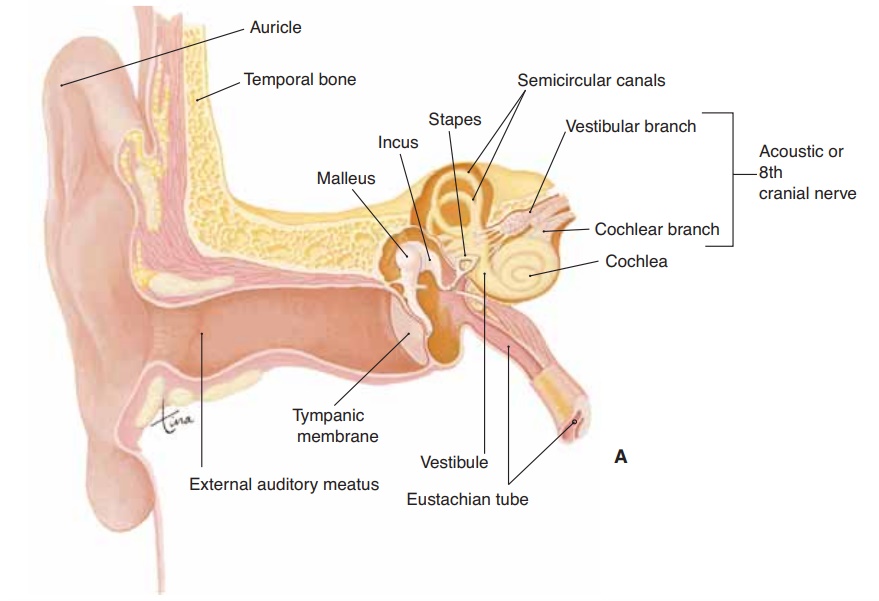
THE EAR
The ear consists of three areas: the outer ear, the mid-dle ear, and the inner ear (Fig. 9–7). The ear contains the receptors for two senses: hearing and equilib-rium. These receptors are all found in the inner ear.
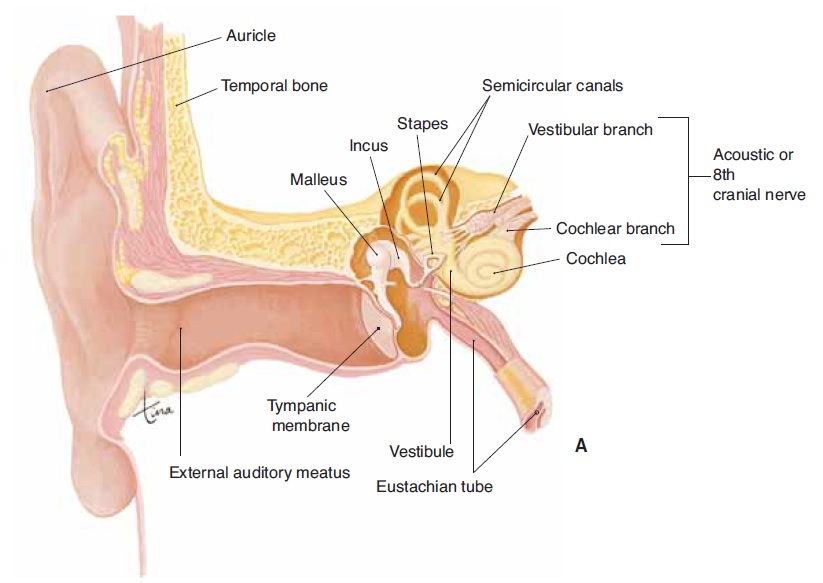
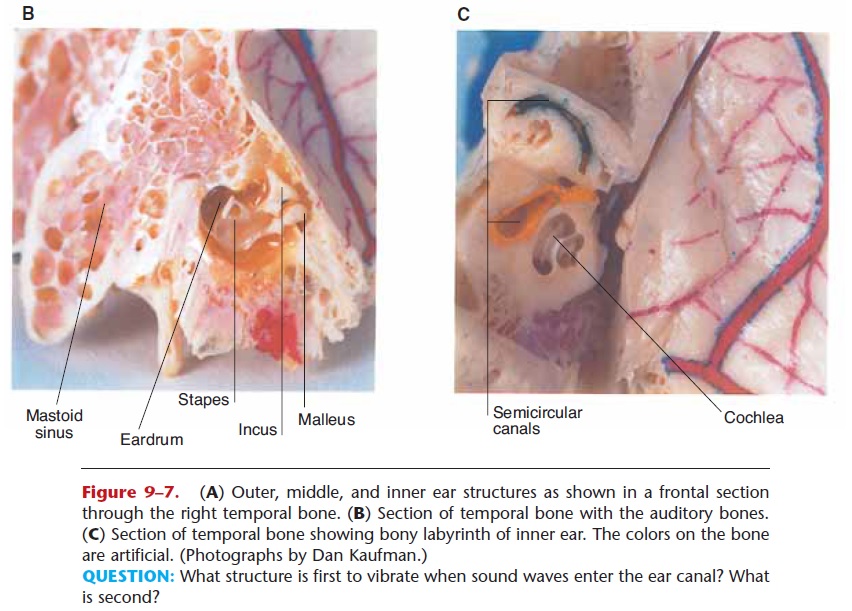
Figure 9–7. (A) Outer, middle, and inner ear structures as shown in a frontal section through the right temporal bone. (B) Section of temporal bone with the auditory bones. (C) Section of temporal bone showing bony labyrinth of inner ear. The colors on the bone are artificial. (Photographs by Dan Kaufman.)
QUESTION: What structure is first to vibrate when sound waves enter the ear canal? What is second?
OUTER EAR
The outer ear consists of the auricle and the ear canal. The auricle, or pinna, is made of cartilage cov-ered with skin. For animals such as dogs, whose ears are movable, the auricle may act as a funnel for sound waves. For people, however, the flat and stationary auricle is not important. Hearing would not be nega-tively affected without it, although those of us who wear glasses would have our vision impaired without our auricles. The ear canal is lined with skin that con-tains ceruminous glands. It may also be called theexternal auditory meatus, and is a tunnel into the temporal bone, curving slightly forward and down.
MIDDLE EAR
The middle ear is an air-filled cavity in the temporal bone. The eardrum, or tympanic membrane, is stretched across the end of the ear canal and vibrates when sound waves strike it. These vibrations are transmitted to the three auditory bones: the malleus, incus, and stapes (see Fig. 9–7). The stapes then transmits vibrations to the fluid-filled inner ear at the oval window.
The eustachian tube (auditory tube) extends from the middle ear to the nasopharynx and permits air to enter or leave the middle ear cavity. The air pressure in the middle ear must be the same as the external atmospheric pressure in order for the eardrum to vibrate properly. You may have noticed your ears “popping” when in an airplane or when driving to a higher or lower altitude. Swallowing or yawning cre-ates the “pop” by opening the eustachian tubes and equalizing the air pressures.
The eustachian tubes of children are short and nearly horizontal and may permit bacteria to spread from the pharynx to the middle ear. This is why otitis media may be a complication of a strep throat.
INNER EAR
Within the temporal bone, the inner ear is a cavity called the bony labyrinth (a labyrinth is a series of interconnecting paths or tunnels, somewhat like a maze but without dead ends; see Fig. 9–7), which is lined with membrane called the membranouslabyrinth. Perilymph is the fluid found between bone and membrane, and endolymph is the fluid within the membranous structures of the inner ear. These struc-tures are the cochlea, concerned with hearing, and the utricle, saccule, and semicircular canals, all concerned with equilibrium (Fig. 9–8).
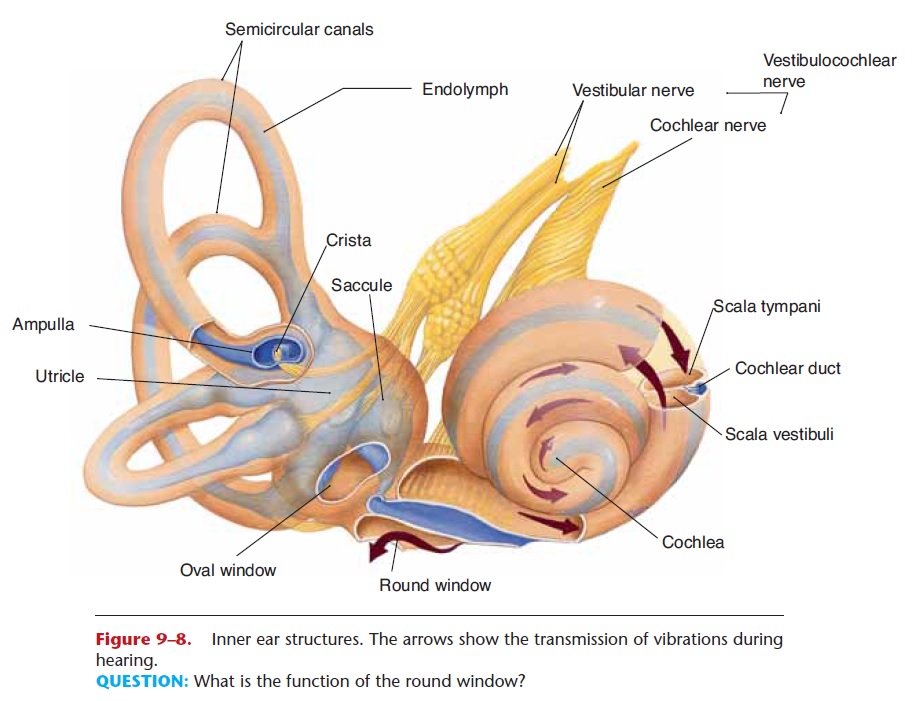
Figure 9–8. Inner ear structures. The arrows show the transmission of vibrations during hearing.
QUESTION: What is the function of the round window?
Cochlea
The cochlea is shaped like a snail shell with two-and-a-half structural turns. Internally, the cochlea is parti-tioned into three fluid-filled canals. The medial canal is the cochlear duct, the floor of which is the basilar membrane that supports the receptors for hearing in the organ of Corti (spiral organ). The receptors are called hair cells (their projections are not “hair,” of course, but rather are specialized microvilli called stereocilia), which contain endings of the cochlear branch of the 8th cranial nerve. Overhanging the hair cells is the tectorial membrane (Fig. 9–9).
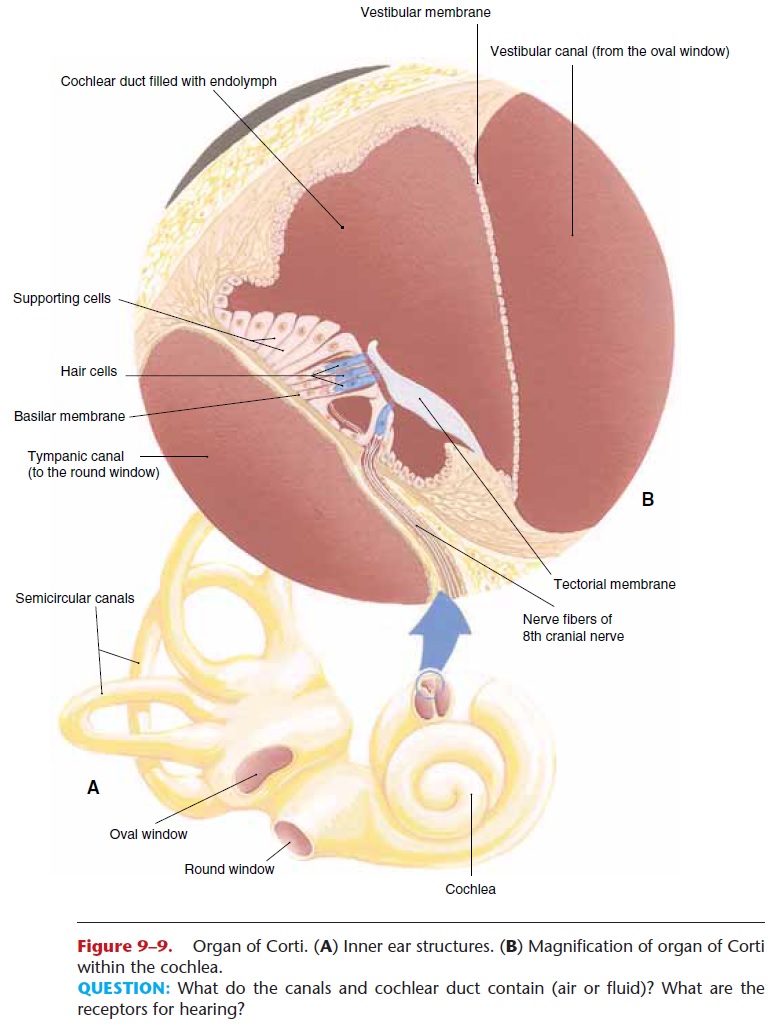
Figure 9–9. Organ of Corti. (A) Inner ear structures. (B) Magnification of organ of Corti within the cochlea.
QUESTION: What do the canals and cochlear duct contain (air or fluid)? What are the receptors for hearing?
Very simply, the process of hearing involves the transmission of vibrations and the generation of nerve impulses. When sound waves enter the ear canal, vibrations are transmitted by the following sequence of structures: eardrum, malleus, incus, stapes, oval window of the inner ear, and perilymph and endolymph within the cochlea. Imagine the vibrations in the fluids as ripples or waves. The basilar mem-brane ripples and pushes the hair cells of the organ of Corti against the tectorial membrane. When the hair cells bend, they generate impulses that are carried by the 8th cranial nerve to the brain. As you may recall, the auditory areas are in the temporal lobes of the cerebral cortex. It is here that sounds are heard and interpreted.
The auditory areas also enable us to determine from which direction a sound is coming. Simply stated, the auditory areas count and compare the num-ber of impulses coming from each inner ear. For example, if more impulses arrive from the left cochlea than from the right one, the sound will be projected to the left. If the source of a sound is directly above your head, the sound may seem to come from all directions, because each auditory area is receiving approximately the same number of impulses and cannot project the sensation to one side or the other.
The final structure in the hearing pathway is the round window (see Fig. 9–8). The membrane-covered round window, just below the oval window, is impor-tant to relieve pressure. When the stapes pushes in the fluid at the oval window, the round window bulges out, which prevents damage to the hair cells.
Utricle and Saccule
The utricle and saccule are membranous sacs in an area called the vestibule, between the cochlea and semicircular canals. Within the utricle and saccule are hair cells embedded in a gelatinous membrane with tiny crystals of calcium carbonate called otoliths. Gravity pulls on the otoliths and bends the hair cells as the position of the head changes (Fig. 9–10). The impulses generated by these hair cells are carried by the vestibular portion of the 8th cranial nerve to the cerebellum, the midbrain, and the temporal lobes of the cerebrum.
The cerebellum and midbrain use this information to maintain equilibrium at a subconscious level. We can, of course, be aware of the position of the head, and it is the cerebrum that provides awareness.
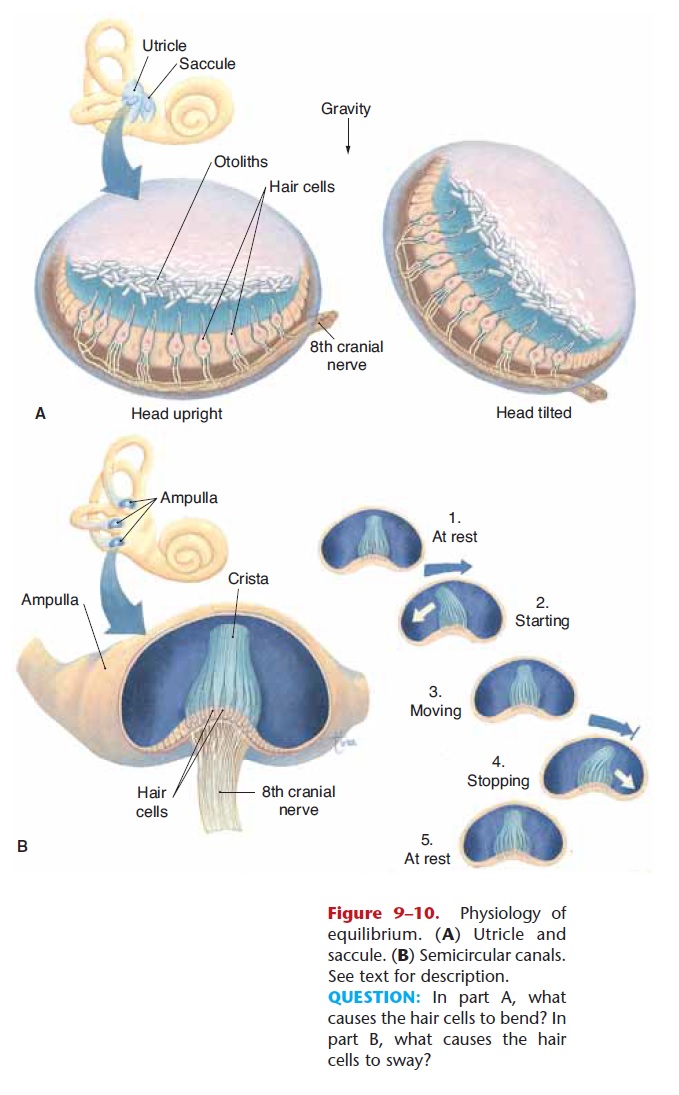
Figure 9–10. Physiology of equilibrium. (A) Utricle and saccule. (B) Semicircular canals. See text for description.
QUESTION: In part A, what causes the hair cells to bend? In part B, what causes the hair cells to sway?
Semicircular Canals
The three semicircular canals are fluid-filled mem-branous ovals oriented in three different planes. At the base of each is an enlarged portion called the ampulla (see Fig. 9–8), which contains hair cells (the crista) that are affected by movement. As the body moves for-ward, for example, the hair cells are bent backward at first and then straighten (see Fig. 9–10). The bend-ing of the hair cells generates impulses carried by the vestibular branch of the 8th cranial nerve to the cerebellum, midbrain, and temporal lobes of the cere- brum. These impulses are interpreted as starting or stopping, and accelerating or decelerating, or chang-ing direction, and this information is used to maintain equilibrium while we are moving.
In summary then, the utricle and saccule provide information about the position of the body at rest, while the semicircular canals provide information about the body in motion. Of course, there is some overlap, and the brain puts all the information together to create a single sense of body position.
Related Topics